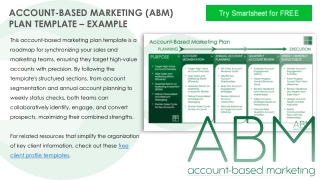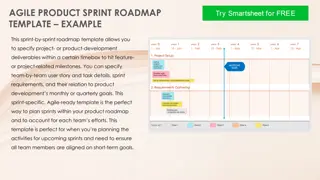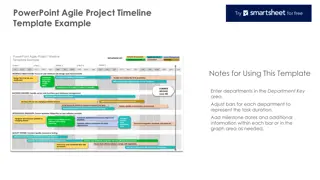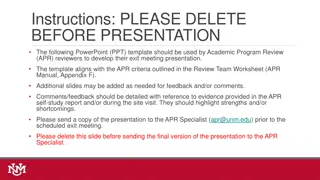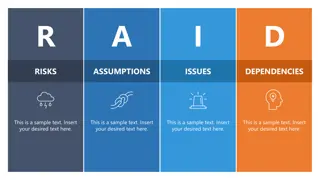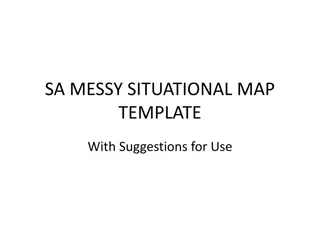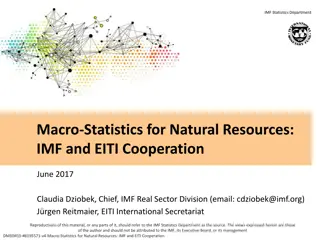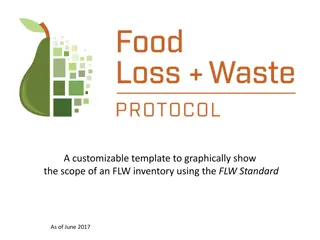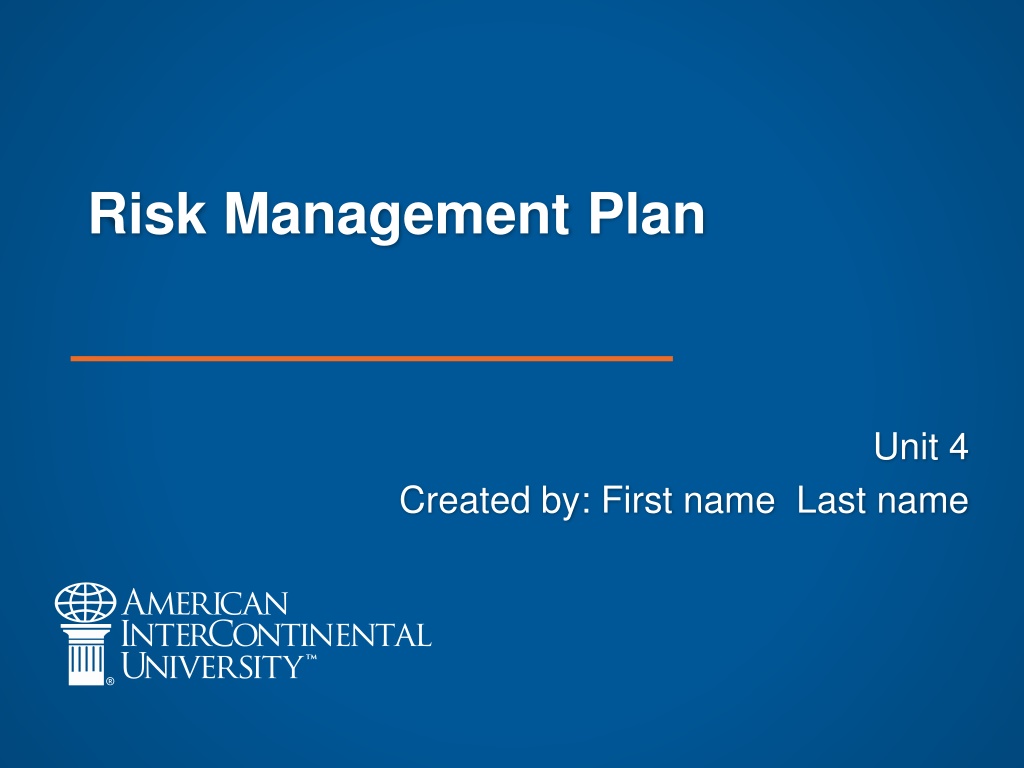
Effective Risk Management Strategies and Tools
This presentation focuses on essential risk management processes like planning, identifying, analyzing, planning responses, and monitoring risks. It also covers techniques for risk identification, key risk breakdown structures, impact, and probability matrices, and response strategies for negative risks. The content includes practical examples and in-depth explanations to help create a comprehensive risk management plan.
Download Presentation

Please find below an Image/Link to download the presentation.
The content on the website is provided AS IS for your information and personal use only. It may not be sold, licensed, or shared on other websites without obtaining consent from the author. If you encounter any issues during the download, it is possible that the publisher has removed the file from their server.
You are allowed to download the files provided on this website for personal or commercial use, subject to the condition that they are used lawfully. All files are the property of their respective owners.
The content on the website is provided AS IS for your information and personal use only. It may not be sold, licensed, or shared on other websites without obtaining consent from the author.
E N D
Presentation Transcript
Risk Management Plan Unit 4 Created by: First name Last name
Risk Management Processes Explanation: Introduce and describe 5 risk management processes (risk planning, identify risks, analyze risks, plan risk responses, and monitor and control). In notes, provide explanations and specific information, at least two sentences per bullet point. Risk Planning: Text Risk Identification: Text, text Risk Analysis: Text, text Qualitative risk analysis: Text, text Quantitative risk analysis: Text, text Plan Risk Responses: text, text Risk Monitoring and Control: text, text 2
Risk Identification Techniques Explanation: Explain tools and techniques to be used to identify risks. In notes, provide explanations and specific information, at least two sentences per bullet point. Brainstorming: Text, text Interviewing: Text, text Experience: Text, text Expert opinion: text, text Root cause analysis: text, text 3
Risk List Explanation: Present 15 key risks identified in Unit 2 homework. In notes, provide explanations and specific information, at least two sentences per bullet point. Example: Risk ID Example 1 2 3 4 5 6 7 8 9 10 11 12 13 14 15 Risk Description Negative Risk Yes Positive Risk Unable to finish homework because Internet is down 4
Risk Breakdown Structure Explanation: Identify key risk assessment categories (budget, schedule, human resources, etc.) with specific project risks identified in Unit 2 homework. In notes, provide explanations and specific information, at least two sentences per bullet point. Example: PROJECT Category 3 Category 1 Category 2 Category 4 Category 5 Example: Technology Risk 1 Example: Complex system interfaces Risk 2 Risk 3 Risk 4 Risk 5 5
Impact and Probability Matrix Explanation: Create Impact and Probability Matrix (high, medium, and low) to define each level of impact and probability. Use Impact and Probability Matrix with specific project risks identified in Unit 2 homework. You do not need any bullet points in this slide. Instead, paste the Impact and Probability Matrix. Use notes to explain Probability and Impact matrix components. Example: IMPACT MEDIUM LOW LOW LOW HIGH MEDIUM LOW PROBABILITY MEDIUM LOW MEDIUM HIGH HIGH MEDIUM HIGH HIGH 6
Risk Response Strategies for Negative Risks Explanation: Explain risk response strategies for negative risks (mitigate, transfer, and avoid). In notes, provide explanations and specific information, at least two sentences per bullet point. Mitigate: Text, text Transfer: Text, text Avoid: Text, text 7
Risk Response Strategies for Positive Risks Explanation: Explain risk response strategies for positive risks (exploit, enhance, and share). In notes, provide explanations and specific information, at least two sentences per bullet point. Exploit: Text, text Enhance: Text, text Share: Text, text 8
Risk Response Strategies for the Project Explanation: Create Risk Response Matrix . You do not need any bullet points in this slide. Instead, paste Risk Response Matrix with specific project risks, identified in Unit 3 homework. Use notes to explain Probability and Impact matrix components. Example: Risk ID Risk Description Response Strategy Mitigate Action Plan Sudden loss of electricity Example 1 2 3 4 5 6 7 8 9 10 11 12 13 14 15 Purchase generators and large fuel canisters 9
Risk Management Roles and Responsibilities Explanation: List five key roles (risk manager, project manager, project sponsor, project team members, etc.) and clarify their responsibilities. In notes, provide explanations and specific information, at least two sentences per bullet point. Role 1: Text, text Role 2: Text, text Role 3: Text, text Role 4: text, text Role 5: text, text 10
Risk Management Budgeting Explanation: Estimate money needed for risk management activities, process of changing budget, and a person responsible for authorizing budget change. Classify your budget into the following categories: labor (people), equipment, materials, other (travel, office supplies, etc.) In notes, provide explanations and specific information, at least two sentences per bullet point. Labor: $ amount Equipment: $ amount Materials: $ amount Other: $ amount How Is in charge of spending?: Text, text How budget changes will be made?: Text, text 11
Risk Management Timing Explanation: Explain frequency of risk management activities (daily, weekly, monthly, ad hoc, etc.), who and how will track timely completion of risk activities, and who will be responsible for authorizing changes to the established timelines. In notes, provide explanations and specific information, at least two sentences per bullet point. Frequency: Text, text Who will track changes?: Text, text Who will authorize changes?: Text, text 12
Risk Types Explanation: Risk threats (negative risks), opportunities (positive risks), internal risks, and external risks. In notes, provide explanations and specific information, at least two sentences per bullet point. Negative risks (threats): Text, text Positive risks (opportunities): Text, text Internal risks: Text, text External risks: text, text 13
Stakeholder Tolerance Explanation: Categorize key stakeholders into two groups: risk averse, and risk seekers. Explain if homogenous or heterogeneous risk teams are preferred by your team) and justify that approach. In notes, provide explanations and specific information, at least two sentences per bullet point. Risk averse: Text, text Risk seekers: Text, text Homogenous: Text, text Heterogeneous: text, text Your team preference?: Text, text 14
Risk Monitoring and Control Explanation: Explain who will audit risks and how frequently the audits will be done. Will you use internal auditors or external auditors? Will you select auditors from risk management team or outside that team? How new risks will be identified? How will you remove risks if they no longer affect your project? Are risk response strategies effective or not? In notes, provide explanations and specific information, at least two sentences per bullet point. Individual(s) responsible for monitoring risks: Text, text Frequency of risk audits: Text, text Will you use auditors from project team or outside the project team?: Text, text How new risks will be identified?: text, text How will outdated risks be removed?: text, text Were risk response strategies effective or not?: Text, text 15
References Instructions: include at least 3 sources used to complete this presentation. All references should be presented in APA format. References 16

